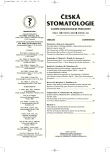The Use of Occlusion Relaxation Splint during Therapy of Temporomandibular Joint Diseases
Authors:
V. Machoň
Authors‘ workplace:
Dětská stomatologická klinika, FN Motol, Praha
přednosta doc. MUDr. J. Kozák, CSc.
Published in:
Česká stomatologie / Praktické zubní lékařství, ročník 106, 2006, 3, s. 93-97
Overview
The author deals with the evaluation of successfulness in the therapy of dysfunction of temporomendibular joint with the application of occlusion relaxation splint. The described study applied a splint made from a thermoplastic foil by a vacuum technique, treating the lowed dental arch in all cases. The therapy lasted three months.
In the evaluation of six months from the beginning of the treatment with the occlusion splint, the therapy was most successful in extracapsular diseases (100%), whereas the works effect was observed in intracapsular diseases (dislocation of the disc with reposition – 31%, disc dislocation without reposition – 55%. It these cases the splint proved to have a marked effect in decreasing pain, whereas a minimum effect was observed on the reposition of the dislocated disc. In the inflammatory-degenerative diseases (arthritis, osteoarthritis) the successfulness proved to be 65%.
Key words:
diseases of tempromandibular joint – occlusion relaxation splint
Labels
Maxillofacial surgery Orthodontics Dental medicineArticle was published in
Czech Dental Journal

2006 Issue 3
Most read in this issue
- The Use of Occlusion Relaxation Splint during Therapy of Temporomandibular Joint Diseases
- Dental Materials and Its Prospective Influence on Oral Mucosa
- Selective Preparation of Hard Dental Tissues in Connection with Composite Materials
- Nanostructured Titan – a New Material for Dental Implants
